On the 14th of February 2017 Stanley Bard, caretaker of the famous Hotel Chelsea, died from a stroke.
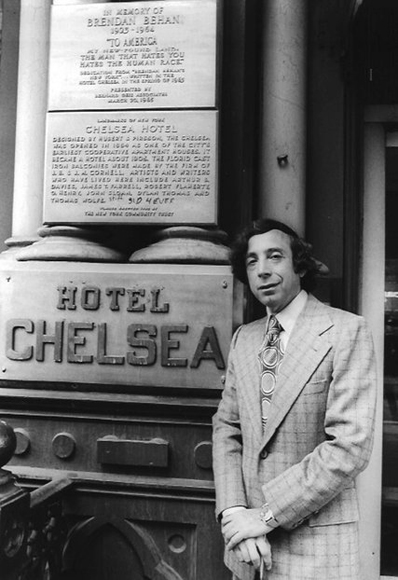
(* photographer ?) “Stanley Bard outside the Chelsea Hotel” (around 1970)
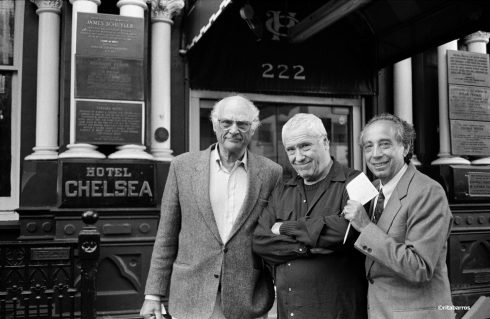
Rita Barros “Arthur Miller at left, Arnold Weinstein center, and Stanley Bard at right” (* date?)
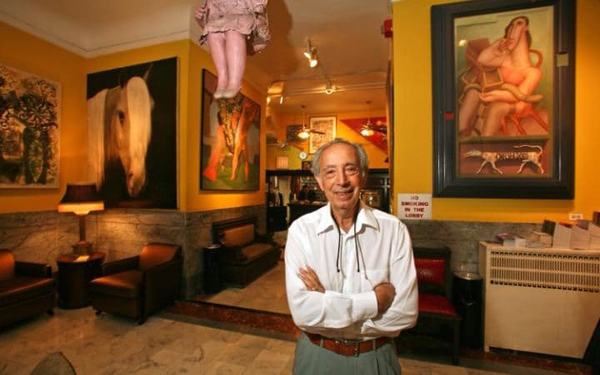
Allan Tannenbaum /POLARIS /EYEVINE “Stanley Bard in the lobby of the Chelsea Hotel” (2006)
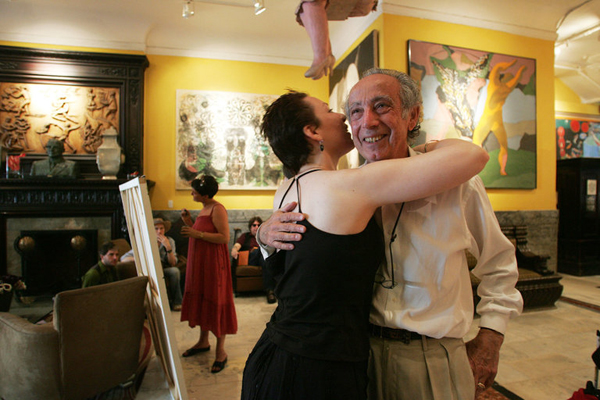
Hiroko Masuike for The New York Times “Stanley Bard, longtime manager and part-owner of the Chelsea Hotel, with Mia Hanson, a photographer and hotel resident” (2007)
Plenty of obituaries have been written in rise of the occasion, which can be easily found online, some of them I will link here, but please look for more if you are interested in the subject:
https://www.nytimes.com/2017/02/14/nyregion/stanley-bard-dead-chelsea-hotel.html
https://www.nytimes.com/2017/02/14/nyregion/stanley-bard-dead-chelsea-hotel.html
and please also watch this talk given by photographer Linda Troeller on “Living Inside the Chelsea Hotel”:
https://www.youtube.com/watch?v=ioxzi93U3Uw
The project ホテル Hotel has been loosely inspired, next to Nan Goldin’s “Ballad of Sexual Dependency” and other artists and their work, by the HOTEL CHELSEA, but more so by the stories and legends about its famous tenants and where they interfere and symbolize my own personal experiences as an artist and person.
The project was started over one year ago in January 2016 and has been ongoing since. I added characters, slowly, as the process of creating the puppets is time and energy consuming, and stories, some are masking personal experiences, some are in relation to daily happenings in politics and social life, but each are meaningful to me, otherwise I would have overlooked them and not been able to comment in form of an artistic translation.
The project has also so far been “my longest long-term project”, “Each reflection of myself echoes a different emotion at me” being the first runner up with a making time of nine months. I was hoping to make ホテル Hotel a “really long-term” project, ideally ongoing over years. I have learned from other projects, in particular “Each reflection” how fulfilling and rewarding it is dedicating myself over long periods of time to one single project and diving very deep into the subject matter, meaning ultimately one’s own psychology from a certain aspect, undertaking my own psycho-analysis by creating, watching and reflecting.
I am not sure anymore this can happen as planned, which in itself reflects the nature of the issue.
I have been asking myself, especially after the project gained some publicity through exhibitions in different countries, what the project means for me and what is the purpose I am working on it. Where the “Each reflection”-project was deliberately a collaboration, and it was my intention creating a project to give other people a voice to express something about themselves and their lives and take myself to the greatest extent out of this process, the project ホテル Hotel is very personal and through it I am investigating my own life; most of the various characters with some very few cameo exceptions are versions of myself, reflecting my own experience and perspectives, masked in form of a group of people and their daily life and choices, and the hotel itself symbolizes me and my life experience and perspectives; in that sense the project is comparable to Mark Hogancamp’s MARWENCOL.
But it seems not only to be that situations occur and I re-tell them in masked version through the story of the hotel, it seems also to apply the other way around: I tell a story through the images of puppets that then seems to happen, parallel to that, in real life.
Parallels of puppets and their originals they stand for or are based on have already become obvious to me when I was frequently asked by collectors and gallerists to sell the figures that stand model for the participants of the “Each reflection”-project.
I was not able to sell them because I felt an inseparable connection between the figures and the people they symbolize, which is the reason why I created a follow-up project “I’m going into the forest” , in which I ritually de-eared the figures, in order to make them permanently unsaleable, (this also because I do need to earn money and don’t trust myself if the temptation seems easy and considerably lucrative.)
Also this current project has shown such a connection between told story and story that is happening, which I don’t have full understanding and insight on, but I am observing it and am cautious of it. I am not a superstitious person, but after having lived in multiple different cultures that all apply different thinking systems on the subject I am open to options I may have previously not been thinking about.
The current recent political events have in a very short time had a strong impact onto my life as on the people living around me and consequently I am considering conclusions that are unexpected and that will interfere with my current work.
Also by thinking and researching a lot about the projects by other artists that inspired my own, and even more so the reaction of the audience over time to these projects, in particular to Nan Goldin’s “Ballad of Sexual Dependency” as well as now, re-newed interest in the HOTEL CHELSEA I realize these are projects that symbolize youth and bohemia and in particular the medium photography has to be always about the past, as there seems currently no way to take a photograph of the future.
I am no longer young, but currently, at the time of writing middle-aged. I am no longer free to spend my nights out in the streets, I live in an apartment and am not squatting with friends in empty houses, and I am no longer able to move to a new country without endless preparations.
I work every day coherently on bodies of work, where admittedly the effort that goes into marketing the work is equal if not bigger than making it.
It is very questionable if this can still be called “bohemia”, likewise I am not sure of work created randomly as the love-child of a creative explosion of an intensive life experience is still marketable, which applies by now the same to visual art as well as music, where the product used to be marketable in small affordable increments of show tickets and opposed to at least four or more digit piece-by-piece gallery prices.
These thoughts made me realize the project ホテル Hotel must be about youth, freedom and a nostalgia for both that is equally shared by myself as well as a general group of the population perhaps of any culture and any social class. Whilst I fondly look back on my youth I do not wish to re-live it and am happy to be where I am in time, but I am over and over questioning if the profession of a visual artist that is trying to put in what is needed to be successful is still or has ever been anything that can be considered a symbol of freedom.
It seems to me, if one wants to be financially successful one has to be willing to be the least free person on earth, accepting a life style that although it markets the artist as a creative, independent and free spirit, in reality turns out people as “artists” that are worse than slaves, because they voluntarily have to take on the most submissive and least free-spirited attitude possible in order to be successful, which makes a job in a cubicle office look adventurous and rewarding.
Or the other way around: which office worker would be willing to over and over send out job-applications and interview multiple times per month, sometimes per week or even several times a day? Some of these applications are on paid basis, and particularly in the media “photography” this has become such a perfect business idea that some galleries are financed by the amount of budding artists, eager to pay for having someone look at their work.
In the State of California in the performing arts the artist is protected from this practice at least in theory by the The Krekorian Talent Scam Prevention Act of 2009, recently brought to discussion through a case in February (2017), when the Los Angeles City Attorney Mike Feuer‘s office filed criminal misdemeanor charges against the operators of five casting workshops for allegedly charging actors for auditions in violation. Are visual artists protected by the same or a similar law?
Who other than an artist would be willing to accept refusals in bulk, if he/she even is graced with a response to an application or introduction? Not to even go into the plenty of times that female artists are being strung along with the promise of some form of marketing of their work as long as they keep up the person’s illusion of sexual interest in return, only to be tossed immediately once that is clarified and out of the question?
All this is the absurdest abuse (whilst ALL ABUSE IS ABSURD) and much of it would be case for a lawsuit in any other job, and yet it is completely normal for a working artist to do and to endure without complaint.
I do not experience the freedom so mythically connected to the life on artist, nor do I see any other full-time artist experience such freedom at all, no matter on what level of success he or she operates;
this is a freedom I felt very strongly as long as I was not professionally marketing my work and was simply making it for the sake of researching things and expressing what I felt to have found.
Instead I feel to be an outcast * of society, either way, successful or not, as soon as I engage in marketing my work on a higher level, perhaps some very few exceptions existing, in which I get the chance to work with equally eccentric gallerists, which is not the norm and very treasured.
I see myself surrounded by working artists who are in exactly the same situation, no matter if they feel it, hate it or love it, because the work and the nature of it that seems necessary to even be able to work professionally is constant and it seems to me degrading, seemingly mostly begging for some form of “audience” with professionals that market art, this must be to such an overhang that as a result such places and people fight off the many advances artists send their way, and the most important question to clarify first of all is: how to get to them anyways?
All this seems to have reached an extent that is bizarre to me.
If there is no interest to support the artist’s work it should not be made, and the artist should look for something else to do what is in higher demand, that a society is willing and able to support. That means a certain perhaps very poetic work at certain times of mankind will not exist. Maybe it will resurface at some point in time.
The question for me is, realizing this, where do I locate my own work and how much longer will I be willing to create it? When will ホテル Hotel be bought out and have to close its doors?
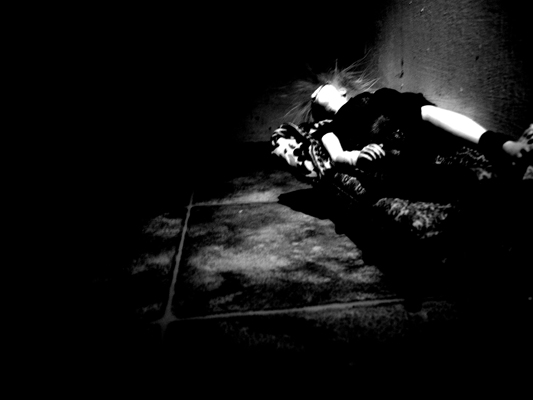
Josiane Keller “Starfish on the sofa 5” (2016)
At the same time “artist” is perhaps one of the few (the only?) profession that is commonly perceived as one anyone can claim to be simply by calling himself so, regardless if he or she has undergone academical training or not or how many years of professional experience he/she has. The question by now is even: aren’t the more wanted artists those who aren’t academically trained, but those who as a living person provide enough stimulation to trigger the voyeuristic fantasies of the bored Bourgeoisie, irrelevant of the quality of their actual work, but more as a form of idol who’s paraphernalia we can purchase and collect? Kissing the pope’s ring still seems to bring some of us closer to God.
And yet it seems important that there is a time span passed to acknowledge such personalities as Gesamtkunstwerk (“complete work of art”), not because all of a sudden our taste has grown up, but because it seems to me, and that is what I experience, most contemporaries in the position of professionally not making but judging art feel extremely threatened by these type of artists, and it becomes safe taking a second look once at least 20, 30 years have passed, perhaps because prior to that, when both are in their youth and same age, the life style of the bohemian artist questions the existence of the art judge too much. Now both have lost their youth, perhaps it comes down to that, and both had their chance to spread their genes, and if they haven’t, too bad, but we are no longer in concurrence with each other, now we can be friends.
A few years ago Nan Goldin was invited to create a show based on paintings of the Louvre, Paris, the result is her project: “Scopophilia” (Louvre Museum, 2010-2011, after that travelling and excerpts shown in various leading galleries). At the time the director of the Louvre was Henry Loyrette. Apparently the project was initiated by Patrice Chéreau, the gay stage and film director (“L’Homme Blessé” / The Wounded Man, 1983, Jean-Hugues Anglade’s first noticeable role playing a young hustler), but apparently this fact was not emphasized upon in the promotion of the show:
http://brooklynrail.org/2011/12/artseen/nan-goldin-scopophilia
Nan Goldin created her most famous work “The Ballad of Sexual Dependency” between 1979 and 1986 in NYC (before it was a “must” to live there and consequently was affordable and dangerous, at least where Nan Goldin lived). Henry Loyette at the same time, 1978 to 1999 was curator at the Musée d’Orsay, Paris.
Henry Loyette born May 31st 1952 and Nan Goldin born Sep 12th 1953 are almost the same age, would Henry Loyette in the 80’s and 90’s have had an interest in befriending Nan Goldin when they were both between 26 and 34 years old, whilst she was right in the middle of living meaning making what is now her most cherished work? Would he have talked to her then, had he met her in a bar, or would they even ever have frequented the same type of bars?
Would he have, as a curator of a major French art museum, have attended one of her early slide-shows? And if he had, perhaps by chance or to have a laugh, would he have contacted her, expressed his interest and suggested at some point in the near or far future a possible exhibition of her work?
Or would he have thought of it is something “with some interesting points, but in need of more time to mature”? Would he have asked her to meet up some time soon for a studio visit, only to be told that there is no studio and the pictures taken are not staged but simply her snap-shots of her and friends’ daily life?
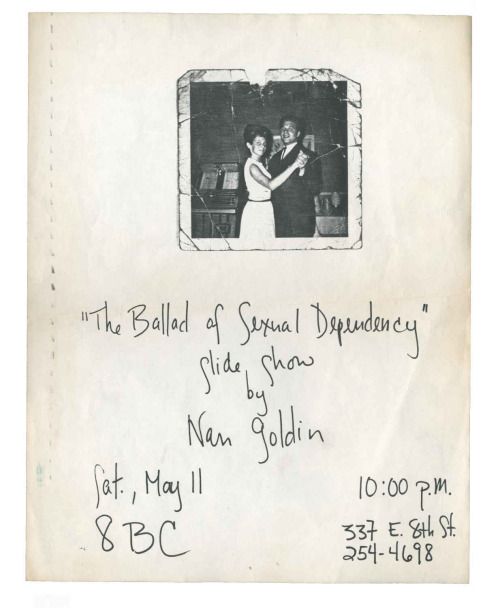
Nan Goldin – Ballad of Sexual Dependency Slide Show-flyer
What if she had said, why don’t you come next week I am having a party? Would he, had this taken place, felt comfortable at the party, or even on the way to it? Or would any attempted conversation collapsed because of unbridgeable differences in communication style, to begin with?
One more interesting observation: there are a number of photographs by Nan Goldin that depict her friends shooting up in NYC as well as other countries, in particular Italy. I have seen these images frequently when I was younger in photo-books, but now despite the omni-potent internet, I can’t seem to find them any more? Where is the image formerly so often seen of the “Junkie-Madonna”, a porcelain statue covered with syringes and notes of believers in some town in Italy, if I recall currently it was taken in Positano? Why are these unpleasant images nowhere to be seen any more, that threaten the romantic dream of the social outlaws with grim reality of addiction, miserable illness and death? Do they seem unsuitable in the marketing strategy of the brand © Nan Goldin or her managers? She has to be wild, untameable but not too nasty?
Is it not often that the most interesting artists are not those who have never seen the bourgeoisie in their upbringing, but instead those who were born right into it and who couldn’t buy into the masked life style and pretended group pleasantries and violently broke out of it, deliberately seeking salvation from emotional suffocation in the opposite, whatever that might be? Isn’t that the reason why both sides seem to look down upon each other? Is it a sign of youth to feel that way so strongly and over time we mellow down?
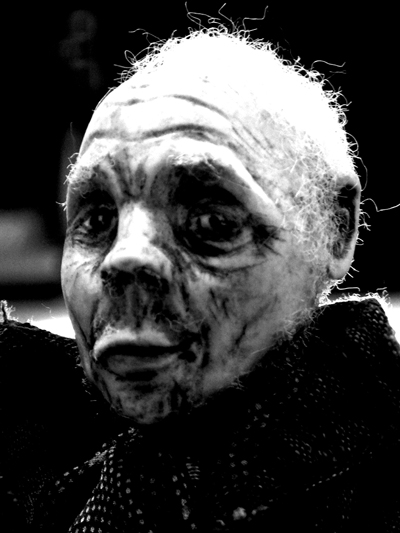
Josiane Keller “Vincent” (* 16th Jun, 1934 – † 14th Feb, 2017)
The differences in social class seems, if not back then, then at least now, too big to be overcome in real life on the 21st century art market, and yet it is this “out-of-reach high up art marketing class” that is majorly interested in the intimate life style of the “low-life scrambling bohemian artists”, it seems even the lower the better, and as can be seen in the example of bohemian New York City: by its own existence destroys the natural habitat of its most beloved prey by making it in-affordable living a life-style that allows thinking people time, reflection and self-reflection, and consequently is left with work that obviously seems to be comfortable, but is ultimately boring, unfulfilling and meaningless, even to themselves.
These thoughts falling together with the death of Stanley Bard made me add his life data to my own character of the caretaker of the hotel Vincent, by doing so the story although currently still unfolding and being told in the present tense, it is clear this is a story about the past.
* perhaps there is a way by self-labeling as an ‘Outsider Artist’ ?
And further: Japanese people believe dolls protect us. So that might be reason enough to keep working.